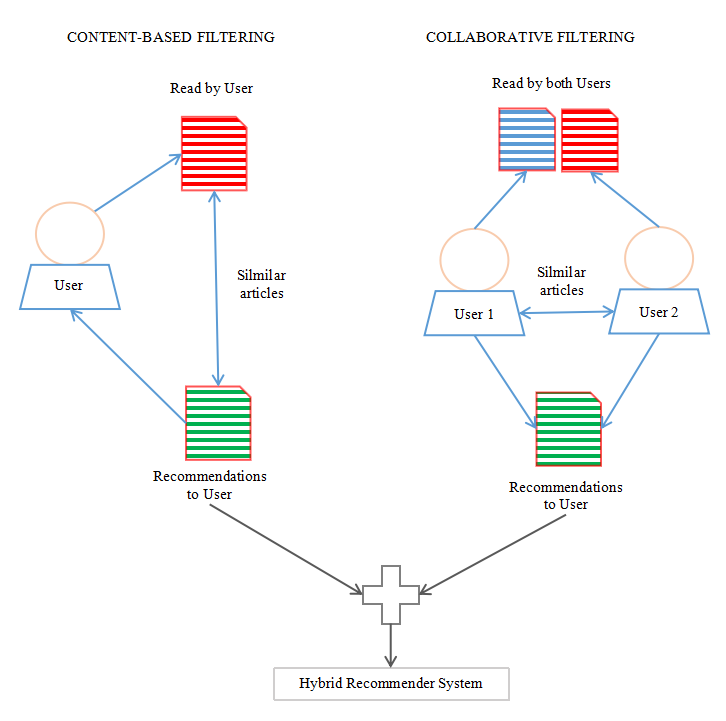An Efficient and Improved Algorithm for a Recommender System to Detect & Recognize Communities in Social Networks
Main Article Content
Abstract
Social Network is a communicative platform which is a part of social media, useful for interaction of information among people i.e. users. There will be millions of users over online Social Networks, they might or might not have similar interests. People with similar interests / mindset would like to have friendly relationship among themselves. Connections with many similar mindset people forms groups or communities. These Communities will be helpful for gaining knowledge/information transmission. In this paper, we will observe efficient methods for recommending groups or communities to users based on their similarities with their friend's or user’s similar to them and groups followed by their friend's, using Hybrid Recommendation Filtering System combined with Singular Value Decomposition.
Article Details
References
Adomavicius, G., & Tuzhilin, A. (2005). Toward the next generation of recommender systems: A survey of the state-of-the-art and possible extensions. IEEE Transactions on Knowledge and Data Engineering, 17(6), 734-749.
Fortunato, S. (2010). Community detection in graphs. Physics Reports, 486(3-5), 75-174.
Girvan, M., & Newman, M. E. (2002). Community structure in social and biological networks. Proceedings of the National Academy of Sciences, 99(12), 7821-7826.
Yang, J., & Leskovec, J. (2012). Community-affiliation graph model for overlapping network community detection.
Ricci, F., Rokach, L., & Shapira, B. (2011). Introduction to recommender systems handbook.
Sarwar, B., Karypis, G., Konstan, J., & Riedl, J. (2001). Item-based collaborative filtering recommendation algorithms.
Blondel, V. D., Guillaume, J. L., Lambiotte, R., & Lefebvre, E. (2008). Fast unfolding of communities in large networks. Journal of Statistical Mechanics: Theory and Experiment, 2008(10), P10008.
Koren, Y., Bell, R., & Volinsky, C. (2009). Matrix factorization techniques for recommender systems. Computer, 42(8), 30-37.
Bell, R. M., Koren, Y., & Volinsky, C. (2007). Modeling relationships at multiple scales to improve accuracy of large recommender systems.
Su, X., & Khoshgoftaar, T. M. (2009). A survey of collaborative filtering techniques.
Desrosiers, C., & Karypis, G. (2011). A comprehensive survey of neighborhood-based recommendation methods.
Bobadilla, J., Ortega, F., Hernando, A., & Gutiérrez, A. (2013). Recommender systems survey.
Resnick P., & Varian H. R. (1997). Recommender systems. Communications of the ACM.
Chen, D., & Zhang, Y. (2014). Data-intensive computing for recommender systems: A survey.
Chen, J., & Liu, X. (2018). A hybrid collaborative filtering recommendation algorithm based on the user's interest degree.
Li, Y., Liu, X., Chen, G., & Cao, L. (2019). A Hybrid Collaborative Filtering Recommendation Algorithm Based on Association Rule Mining and User Preference Division.
Lee, J. H., & Choi, Y. S. (2016). A recommender system based on product images using deep learning.
Sedhain, S., Menon, A., Sanner, S., & Xie, L. (2015). Autorec: Autoencoders meet collaborative filtering.
Cheng, Y., Li, G., Liu, L., & Chen, T. (2018). A neural autoregressive approach to collaborative filtering.
Li, Y., & She, J. (2018). Collaborative filtering recommendation algorithm based on deep belief network.
He, X., Liao, L., Zhang, H., Nie, L., Hu, X., & Chua, T. S. (2017). Neural collaborative filtering.
Leskovec, J., Rajaraman, A., & Ullman, J. D. (2014). Mining of Massive Datasets. Cambridge University Press.
Mohammed AL-Mafrji, A. A. ., Fakhrudeen, A. M. ., & Chaari, L. . (2023). Expert Systems in Banking: Artificial Intelligence Application in Supporting Banking Decision-Making. International Journal of Intelligent Systems and Applications in Engineering, 11(4s), 61–69. Retrieved from https://ijisae.org/index.php/IJISAE/article/view/2572
Newman, M. E. (2004). Fast algorithm for detecting community structure in networks. Physical Review E, 69(6), 066133.
Koren, Y. (2008). Factorization Meets the Neighborhood: A Multifaceted Collaborative Filtering Model. In Proceedings of the 14th ACM SIGKDD International Conference on Knowledge Discovery and Data Mining (pp. 426-434).
Newman, M. E., & Girvan, M. (2004). Finding and evaluating community structure in networks. Physical Review E, 69(2), 026113.
Breese, J. S., Heckerman, D., & Kadie, C. (1998). Empirical analysis of predictive algorithms for collaborative filtering. In Proceedings of the 14th Conference on Uncertainty in Artificial Intelligence (pp. 43-52).
Johnson, M., & Smith, A, (April 2018) A Hybrid Approach using Collaborative filtering and Content based Filtering for Recommender System Journal of Physics Conference Series.
Han, J., Kamber, M., & Pei, J. (2011). Data mining: concepts and techniques. Morgan Kaufmann.
Newman, M. E. J. (2010). Networks: An Introduction. Oxford University Press.
Mr. R. Senthil Ganesh. (2019). Watermark Decoding Technique using Machine Learning for Intellectual Property Protection . International Journal of New Practices in Management and Engineering, 8(03), 01 - 09. https://doi.org/10.17762/ijnpme.v8i03.77
Barabási, A. L. (2016). Network Science. Cambridge University Press.
Golub, G. H., & Van Loan, C. F. (2012). Matrix computations. Johns Hopkins University Press.
Ding, C., Li, T., & Jordan, M. I. (2006). Convex and semi-nonnegative matrix factorizations. IEEE Transactions on Pattern Analysis and Machine Intelligence, 32(1), 45-55.
Ricci, F., Rokach, L., & Shapira, B. (2015). Recommender systems handbook. Springer.
Smit, S., Popova, E., Mili?, M., Costa, A., & Martínez, L. Machine Learning-based Predictive Maintenance for Industrial Systems. Kuwait Journal of Machine Learning, 1(3). Retrieved from http://kuwaitjournals.com/index.php/kjml/article/view/139
Li, Y., Zhao, T., & Zhang, G. (August 2006). "Evaluation Metrics for Recommender Systems."
Basu, C., Hirsh, H., & Cohen, W. (1998). Recommendation as classification: Using social & content-based information in recommendation. In Proceedings of the 15th National Conference on Artificial Intelligence (pp. 714-720).
Anderson, Chris. (2006). The Long Tail: Why the Future of Business is Selling Less of More. New York, Hyperion. 238 pp.
Collaborative Recommender System -builtin.com/data-science/collaborative-filtering-recommender-system
SNAP dataset repository- snap.stanford.edu. This repository is maintained by Stanford Engineering College - cs.stanford.edu

